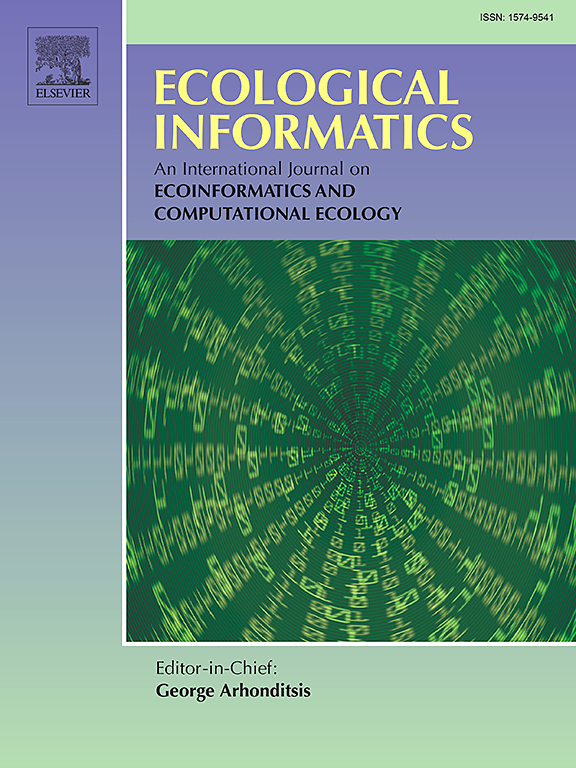从水下到无人机:一种新的珊瑚礁监测多尺度知识蒸馏方法
IF 5.8
2区 环境科学与生态学
Q1 ECOLOGY
引用次数: 0
摘要
基于无人机的遥感与人工智能驱动的方法相结合,在珊瑚礁生态系统的精确测绘和监测方面显示出巨大的潜力。本研究提出了一种新的多尺度珊瑚礁监测方法,将细尺度水下图像与中尺度航空图像相结合。水下图像由自主水面车辆(ASV)捕获,空中图像由空中无人机获取。基于转换器的深度学习模型在水下图像上进行训练,以检测覆盖各种珊瑚形态、相关动物群和栖息地的31类珊瑚的存在。对于航空分析,这些预测被改进(一些类别被合并,其他类别被保留,而一些被删除),最终产生12个生态类别,作为训练应用于航空图像的第二个模型的注释。跨尺度的信息传递是通过加权足迹方法实现的,该方法考虑了水下图像足迹和航空图像瓦片之间的部分重叠。结果表明,多尺度方法成功地将精细尺度分类扩展到更大的珊瑚礁区域,在预测珊瑚形态和相关栖息地方面取得了很高的准确性。该方法的AUC (Area Under The Curve,曲线下面积)得分为0.9251,表明水下衍生的注释与地面真实数据具有较强的一致性。这表明,在深度学习模型的支持下,水下和空中图像的整合可以促进可扩展和准确的珊瑚礁评估。本研究将多尺度成像与人工智能相结合,为珊瑚礁监测与保护提供科学信息。我们的方法利用水下和空中图像,旨在实现精细分析的精度,同时将其扩展到更广泛的珊瑚礁区域。本文章由计算机程序翻译,如有差异,请以英文原文为准。

From underwater to drone: A novel multi-scale knowledge distillation approach for coral reef monitoring
Drone-based remote sensing combined with AI-driven methodologies has shown great potential for accurate mapping and monitoring of coral reef ecosystems. This study presents a novel multi-scale approach to coral reef monitoring, integrating fine-scale underwater imagery with medium-scale aerial imagery. Underwater images are captured using an Autonomous Surface Vehicle (ASV), while aerial images are acquired with an aerial drone. A transformer-based deep-learning model is trained on underwater images to detect the presence of 31 classes covering various coral morphotypes, associated fauna, and habitats. For aerial analysis these predictions are refined (some classes are merged, others are retained, while some are removed) resulting in a final set of 12 ecological categories that serve as annotations for training a second model applied to aerial images. The transfer of information across scales is achieved through a weighted footprint method that accounts for partial overlaps between underwater image footprints and aerial image tiles. The results show that the multi-scale methodology successfully extends fine-scale classification to larger reef areas, achieving a high degree of accuracy in predicting coral morphotypes and associated habitats. The method showed a strong alignment between underwater-derived annotations and ground truth data, reflected by an AUC (Area Under the Curve) score of 0.9251. This shows that the integration of underwater and aerial imagery, supported by deep-learning models, can facilitate scalable and accurate reef assessments. This study combines multi-scale imaging and AI to provide scientific information on coral reef monitoring and conservation. Our approach leverages underwater and aerial imagery, aiming for the precision of fine-scale analysis while extending it to cover a broader reef area.
求助全文
通过发布文献求助,成功后即可免费获取论文全文。
去求助
来源期刊

Ecological Informatics
环境科学-生态学
CiteScore
8.30
自引率
11.80%
发文量
346
审稿时长
46 days
期刊介绍:
The journal Ecological Informatics is devoted to the publication of high quality, peer-reviewed articles on all aspects of computational ecology, data science and biogeography. The scope of the journal takes into account the data-intensive nature of ecology, the growing capacity of information technology to access, harness and leverage complex data as well as the critical need for informing sustainable management in view of global environmental and climate change.
The nature of the journal is interdisciplinary at the crossover between ecology and informatics. It focuses on novel concepts and techniques for image- and genome-based monitoring and interpretation, sensor- and multimedia-based data acquisition, internet-based data archiving and sharing, data assimilation, modelling and prediction of ecological data.
 求助内容:
求助内容: 应助结果提醒方式:
应助结果提醒方式:


